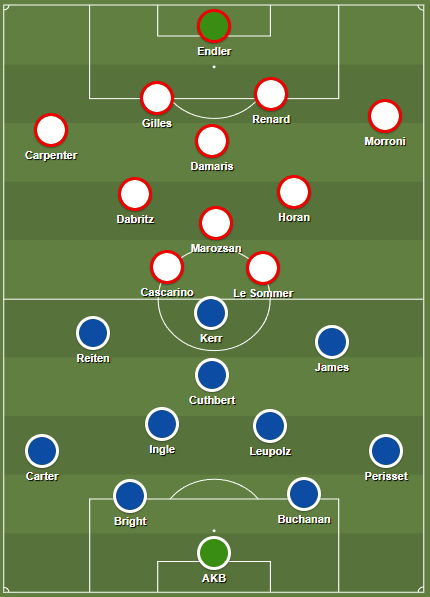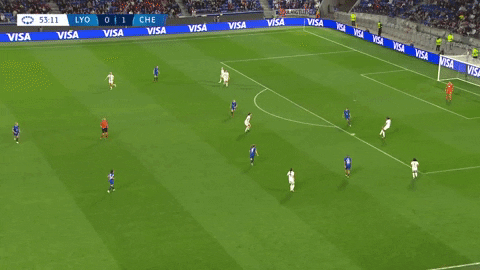Chelsea v Lyon Preview: A case for Lyon's progression to the semi-final
Lyon take on Chelsea at Stamford Bridge in what promises to be a classic European night under the lights.
Last Wednesday, the first leg between the two European giants ended in a slim 1-0 win for Chelsea. The game was tactically interesting and although there was a bright start for Lyon, Chelsea slowly grew into the game and offered a glimpse of the promise they’ve been threatening to show in Europe this season.
The second leg at Stamford Bridge promises to be an all-time classic given Lyon’s need to win and their historic knack for showing up when it really counts. For Chelsea, it becomes a momentous occasion to knock out the current holders and give themselves confidence going into another European semi-final.
Did Lyon’s 4-4-2 Diamond work?
Lyon’s move to a 4-4-2 diamond this season has been a slight surprise. They’ve suffered a few injuries, but this transformation has mainly come considering their struggle to score goals. Moving to a system that both accommodates their gifted central midfielders and creates a dual-focused two-striker system theoretically allows them more chances to score.
The returns of Selma Bacha, Ellie Carpenter, Sara Däbritz, Dzsenifer Marozsan, and Ada Hegerberg all provide a massive boost for the French side and at such a crucial time. Though the Norwegian striker did not play a part in the first leg, there is a sense of optimism that she could start the second leg where her influence can no doubt be a great asset to the team.
So, why would this formation be more interesting for Lyon?
Well, for Lyon it means they’re able to play with a true No. 10 and use Marozsan in her most natural role. The German’s return from injury and indifferent form over the last 18 months has meant her being dropped back and shoehorned into a No. 8 role previously in a 4-3-3 but while the change is different, the formation has its upsides.
The formation brings in all of Lyon’s strongest players whilst allowing their flying full-backs the space to fly forward and provide the width. The two full-backs are arguably the primary difference-makers, giving the team some much-needed speed and, most importantly, an outlet for the central players to relieve pressure. By concentrating on the central spaces, Lyon can physically dominate the midfield battle through technical proficiency and speed in the wide areas. Having Delphine Cascarino as the second forward means there’s an extra outlet to drift wide and provide a crossing option.
Against Chelsea’s 4-2-3-1 system, Lyon had hoped to force Chelsea wingers to tuck inside and allow their full-backs access to fly forward. Both Ellie Carpenter and Perle Morroni would provide width and not only give Lyon an alternative source of chance creation but also ensure that Guro Reiten and Lauren James were pegged back in defensive positions.
For the first 20 minutes or so, the game plan worked. Lyon gained sufficient control in the middle third, and coupled with Chelsea’s poor control and some positional deficiencies, it meant they were in control of possession. Damaris, Horan, and Däbritz shuffled across and rotated the ball to bring the full-backs in as the focal point of attack effectively. Equally, they used the No. 10, Marozsan, to drop in between the lines to pick up and play through the defence. The dual striker system was used to ensure Chelsea’s backline was stretched; Millie Bright and Kadiesha Buchanan are not the quickest, thus forcing them to play deeper was a way of creating this space.
Renard wins the ball back in transition and pushes Lyon forward. Le Sommer drops into space whilst Marozsan pushes forward. The Chelsea midfield is looking to re-organise and get into shape but there’s enough time for Lyon to manoeuvre in the space. Marozsan receives the ball in acres of space and picks out Carpenter making a marauding run down the right.
Chelsea badly needed to congest the central areas to stop Lyon’s multitude of midfielders and attackers from overloading them which gave the wide players the space to run through. As you can see in the passage above, though the ball goes out of play, it’s just one example of how Lyon created opportunities using their shape to their advantage.
The shape here is a perfect example of where Lyon had an upper hand against Chelsea in the build-up. Covering the passing lanes here means Chelsea were forced to go long into the channels. With Chelsea’s shape a lot deeper and more spread out, Kerr becomes a very isolated figure. They defended in a similar off-the-ball shape except you’d see one of the central midfielders drop in next to Damaris to form a double pivot, whether it be Marozsan, Däbritz, or Horan. They could afford to do this because Chelsea’s full-backs were more reserved in their role with both Jess Carter and Eve Perisset having no interest in pushing forward.
If we’re to pinpoint where Lyon can gain some more joy going into the midweek clash, then we can look no further than Chelsea’s game against Manchester City over the weekend. Similar to what Chelsea were doing to Lyon, there is evidence that the back line can be susceptible to pace. Against Manchester City, Chelsea were caught out by both the press and a lack of a proper midfield controller. Granted, they were missing Bright, but the backline should nonetheless still be capable of handling a world-class forward line. How Chelsea choose to play out through their longer passes which gives Kerr the space to run the channels – particularly given that Pernille Harder and Fran Kirby have both been injured for a significant period of time, is very much the core of their tactical identity this season so far. You might even say that Chelsea are predictable in their build-up because of that, and given how their centre-backs are more comfortable in dribbling out with the ball as well as the lack of a sensible midfield passing option, there is a clear way to stop Chelsea.
If Lyon can press Chelsea higher up the pitch and apply enough pressure to seek misplaced passes more than interceptions, then there’s a good chance to create dangerous transitional opportunities in the final third just as we saw with Magdalena Eriksson’s misplaced pass when playing out from the back.
Chelsea’s counter-punch
Given the initial dominance from Lyon, Chelsea’s game plan was quite obvious: hold shape, win possession in transition, and not worry about having the ball. A starting formation of a 4-2-3-1 quickly transformed between that and a 4-4-2 on and off the ball as Chelsea wanted to counter with pace and physicality in midfield. James would naturally tuck inside but Reiten’s role was to stretch Lyon and use the space in behind Carpenter, knowing she was the primary outlet for the French champions.
The setup in their off-the-ball shape was a strict 4-4-2 when defending, where they wanted to confine Lyon from going through the middle and were happy to let Carpenter and Morroni attack the wings instead. Given that Morroni is less proficient going forward, the onus fell on Carpenter but her effectiveness was limited. A rusty return meant she provided less of a threat going forwards.
The foundation of this setup was built from Chelsea’s midfield three and it was quite telling when Erin Cuthbert was selected to play as the No. 10 which enabled Chelsea to have a destructive midfielder higher up the pitch to not only win the ball back, but to also disrupt any passing opportunities into Lyon’s technical midfield. Damaris is a key figure in Lyon’s midfield and is the crux of the second phase of build-up, so keeping her quiet would go a long way in disrupting Lyon’s flow. She is the conduit that connects Däbritz, Horan, and Marozsan together to flow seamlessly.
This inevitably is where the goal came from. A 50-50 duel between Carpenter and Erin Cuthbert in the middle was followed by a quick drive from the Scottish midfielder before finding a free Reiten on the left flank. The space left in behind by Carpenter was expertly used thanks to Reiten’s positioning and intelligence in timing her runs to the interior channels. The finish itself was exquisite with a right-footed strike from the Norwegian winger. This space is where Chelsea could get more joy in the second leg if Lyon opt to continue with the 4-4-2 diamond.
Another method of playing in transition for Chelsea was their switch of play. The first half had chances few and far between but the second proved to be much better for the Blues, where they were able to dictate play a lot more. Melanie Leupolz was outstanding in her role as the box-to-box midfielder and had moments of driving with the ball, flying past the Lyon midfielders. This enabled her to create a switch of play towards the wings just as she shows here with her pass to Reiten.
The second leg might end up being not all that different and given Chelsea will be playing at home, the need to be as defensive in a setup including Melanie Leupolz and Sophie Ingle might not be required. Lyon will be on the attack and having a duo of Cuthbert and Ingle could be enough to disrupt Lyon’s flow. If Lyon can nullify those two and play quicker around them, then there’s a chance to expose and get at Chelsea’s backline. Though it was Buchanan’s most assured performance in a Chelsea shirt during their last encounter, the partnership of Buchanan and Eriksson is still relatively untested and could mean more chances for Lyon to break through.
How can the teams change?
Against Guingamp Lyon reverted to a 4-3-3 – partly to rest their key midfielders, but this could also see them switch to the formation that suits Hegerberg. The number of crosses sent in by Lyon against Chelsea was crying for a recognised centre-forward with aerial prowess and Hegerberg provides exactly that. When she came on against Guingamp, Hegerberg scored a goal within 30 seconds which showed how much Lyon miss their talismanic striker.
Regardless of the 4-3-3 or diamond shape, Hegerberg’s inclusion will give Lyon a focal point, and most importantly, a player to occupy the centre-backs. With the possibility of no Millie Bright for the second leg, it will be a tougher task for Magdalena Eriksson and Buchanan to handle the Norwegian.
I’d go with the 4-3-3, simply because it unlocks the attacking prowess of Lyon’s wingers. Starting Selma Bacha and Delphine Cascarino with Hegerberg is critical in penetrating Chelsea’s defence. Danielle Van de Donk had a very positive effect in what was a poor second half for Lyon and could bring a mixture of physicality and creativity in a game that needs both.
Assuming Chelsea continue with their 4-2-3-1 system and play a similar team to that in the first leg, the onus is on Lyon to push forward and create. I do believe that Chelsea will try to control possession a bit more this time, but the game could very quickly turn into a repeat of the first leg with Lyon looking to dominate on the ball. While there should be no reason to change the team – unless there’s a doubt over Cuthbert’s fitness – I would think about possibly bringing in Jelena Cankovic to provide a level of creativity and control in midfield.
Regardless of the decisions, the second leg should prove to be a night to remember for both teams.
Photo by Harriet Lander - Chelsea FC/Chelsea FC via Getty Images








